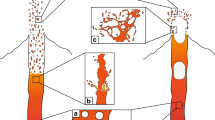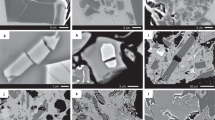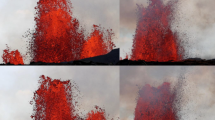Abstract
The fragmentation of magma, containing abundant gas bubbles, is thought to be the defining characteristic of explosive eruptions1,2,3. When viscous stresses associated with the growth of bubbles and the flow of the ascending magma exceed the strength of the melt2,4,5,6, the magma breaks into disconnected fragments suspended within an expanding gas phase. Although repeated effusive and explosive eruptions for individual volcanoes are common7,8, the dynamics governing the transition between explosive and effusive eruptions remain unclear. Magmas for both types of eruptions originate from sources with similar volatile content, yet effusive lavas erupt considerably more degassed than their explosive counterparts7,8. One mechanism for degassing during magma ascent, consistent with observations, is the generation of intermittent permeable fracture networks generated by non-explosive fragmentation near the conduit walls9,10,11. Here we show that such fragmentation can occur by viscous shear in both effusive and explosive eruptions. Moreover, we suggest that such fragmentation may be important for magma degassing and the inhibition of explosive behaviour. This implies that, contrary to conventional views, explosive volcanism is not an inevitable consequence of magma fragmentation.
This is a preview of subscription content, access via your institution
Access options
Subscribe to this journal
Receive 51 print issues and online access
$199.00 per year
only $3.90 per issue
Buy this article
- Purchase on Springer Link
- Instant access to full article PDF
Prices may be subject to local taxes which are calculated during checkout



Similar content being viewed by others
References
Eichelberger, J. C. Silicic volcanism: ascent of viscous magmas from crustal reservoirs. Annu. Rev. Earth Planet. Sci. 23, 41–63 (1995)
Dingwell, D. B. Volcanic dilemma: Flow or blow? Science 273, 1054–1055 (1996)
Papale, P. Strain-induced magma fragmentation in explosive eruptions. Nature 397, 425–428 (1999)
Dingwell, D. B. & Webb, S. L. Structural relaxation in silicate melts and non-Newtonian melt rheology in geologic processes. Phys. Chem. Miner. 16, 508–516 (1989)
Webb, S. L. & Dingwell, D. B. The onset of non-Newtonian rheology of silcate melts. Phys. Chem. Miner. 17, 125–132 (1990)
Webb, S. L. & Dingwell, D. B. Non-Newtonian rheology of igneous melts at high stresses and strain rates: experimental results for rhyolite, andesite, basalt, and nephelinite. J. Geophys. Res. 95, 15695–15701 (1990)
Newman, S., Epstein, S. & Stolper, E. Water, carbon dioxide and hydrogen isotopes in glasses from the ca. 1340 A.D. eruption of the Mono Craters, California: Constraints on degassing phenomena and initial volatile content. J. Volcanol. Geotherm. Res. 35, 75–96 (1988)
Villemant, B. & Boudon, G. Transition from dome-forming to plinian eruptive styles controlled by H2O and Cl degassing. Nature 392, 65–69 (1998)
Polacci, M., Papale, P. & Rosi, M. Textural heterogeneities in pumices from the climactic eruption of Mount Pinatubo, 15 June 1991, and implications for magma ascent dynamics. Bull. Volcanol. 63, 83–97 (2001)
Tuffen, H., Dingwell, D. B. & Pinkerton, H. Repeated fracture and healing of silicic magma generates flow banding and earthquakes? Geology 31, 1089–1092 (2003)
Stasiuk, M. V. et al. Degassing during magma ascent in the Mule Creek vent (USA). Bull. Volcanol. 58, 117–130 (1996)
Goto, A. A new model for volcanic earthquake at Unzen Volcano: Melt rupture model. Geophys. Res. Lett. 26, 2541–2544 (1999)
Mastin, L. G. Insights into volcanic conduit flow from an open-source numerical model. Geochem. Geophys. Geosyst. 3, doi:10.1029/2001GC000192 (2002)
Proussevitch, A. A., Sahagian, D. L. & Anderson, A. T. Dynamics of diffusive bubble growth in magmas: Isothermal case. J. Geophys. Res. 3, 22283–22307 (1993)
Lensky, N. G., Lyakhovsky, V. & Navon, O. Radial variations of melt viscosity around growing bubbles and gas overpressure in vesiculating magmas. Earth Planet. Sci. Lett. 186, 1–6 (2001)
Rust, A. C. & Manga, M. Effects of bubble deformation on the viscosity of dilute suspensions. J. Non-Newtonian Fluid Mech. 104, 53–63 (2002)
Pal, R. Rheological behavior of bubble-bearing magmas. Earth Planet. Sci. Lett. 207, 165–179 (2003)
Llewellin, E. W., Mader, H. M. & Wilson, S. D. R. The constitutive equation and flow dynamics of bubbly magmas. Geophys. Res. Lett. 29, doi:10.1029/2002GL015697 (2002)
Simmons, J. H., Mohr, R. K. & Montrose, C. J. Non-Newtonian viscous flow in glass. J. Appl. Phys. 53, 4075–4080 (1982)
Hess, K.-U. & Dingwell, D. B. Viscosities of hydrous leucogranitic melts: A non-Arrhenian model. Am. Mineral. 81, 1297–1300 (1996)
Manga, M. & Loewenberg, M. Viscosity of magmas containing highly deformable bubbles. J. Volcanol. Geotherm. Res. 105, 19–24 (2001)
Pyle, D. M. in Encyclopedia of Volcanoes (eds Sigurdsson, H., Houghton, B. F., McNutt, S. R., Rymer, H. & Stix, J.) 263–269 (Academic, San Diego, 2000)
Jaupart, C. & Allegre, C. J. Gas content, eruption rate and instabilities of eruption regime in silicic volcanoes. Earth Planet. Sci. Lett. 102, 413–429 (1991)
Boudon, G., Villemant, B., Komorowski, J.-C., Ildefonse, P. & Semet, M. P. The hydrothermal system at Soufriere Hills volcano, Montserrat (West Indies): characterization and role in the on-going eruption. Geophys. Res. Lett. 25, 3693–3696 (1998)
Blower, J. D. Factors controlling porosity-permeability relationships in magma. Bull. Volcanol. 63, 497–504 (2001)
Klug, C. & Cashman, K. V. Permeability development in vesiculating magmas: implications for fragmentation. Bull. Volcanol. 58, 87–100 (1996)
Klug, C., Cashman, K. V. & Bacon, C. R. Structure and physical characteristics of pumice from the climactic eruption of Mount Mazama (Crater Lake), Oregon. Bull. Volcanol. 64, 486–501 (2002)
Gottsmann, J. & Dingwell, D. B. The thermal history of a spatter-fed lava flow: the 8-ka pantellerite flow of Mayor Island, New Zealand. Bull. Volcanol. 64, 410–422 (2002)
Smith, J. V. Ductile-brittle transition structures in the basal shear zone of a rhyolite lava flow, eastern Australia. J. Volcanol. Geotherm. Res. 72, 217–223 (1996)
Martel, C., Dingwell, D. B., Spieler, O., Pichavant, M. & Wilke, M. Experimental fragmentation of crystal- and vesicle-bearing melts. Bull. Volcanol. 63, 398–405 (2001)
Acknowledgements
We thank P. Papale and D. L. Sahagian for comments on the previous versions of the manuscript, and K. V. Cashman, A. Rust, and A. M. Jellinek for comments on earlier versions. This work was supported by the National Science Foundation and the Sloan Foundation.
Author information
Authors and Affiliations
Corresponding author
Ethics declarations
Competing interests
The authors declare that they have no competing financial interests.
Rights and permissions
About this article
Cite this article
Gonnermann, H., Manga, M. Explosive volcanism may not be an inevitable consequence of magma fragmentation. Nature 426, 432–435 (2003). https://doi.org/10.1038/nature02138
Received:
Accepted:
Issue Date:
DOI: https://doi.org/10.1038/nature02138
This article is cited by
-
Oxide nanolitisation-induced melt iron extraction causes viscosity jumps and enhanced explosivity in silicic magma
Nature Communications (2024)
-
In situ observation of glass-like fragmentation of high-temperature silicate melts generating fine ashes
Communications Earth & Environment (2023)
-
The exposed Mule Creek vent deposits record the structure of a volcanic conduit during a hybrid explosive–effusive eruption
Bulletin of Volcanology (2023)
-
Detecting multiscale periodicity from the secular effusive activity at Santiaguito lava dome complex (Guatemala)
Earth, Planets and Space (2022)
-
Open-vent volcanoes fuelled by depth-integrated magma degassing
Bulletin of Volcanology (2022)
Comments
By submitting a comment you agree to abide by our Terms and Community Guidelines. If you find something abusive or that does not comply with our terms or guidelines please flag it as inappropriate.



